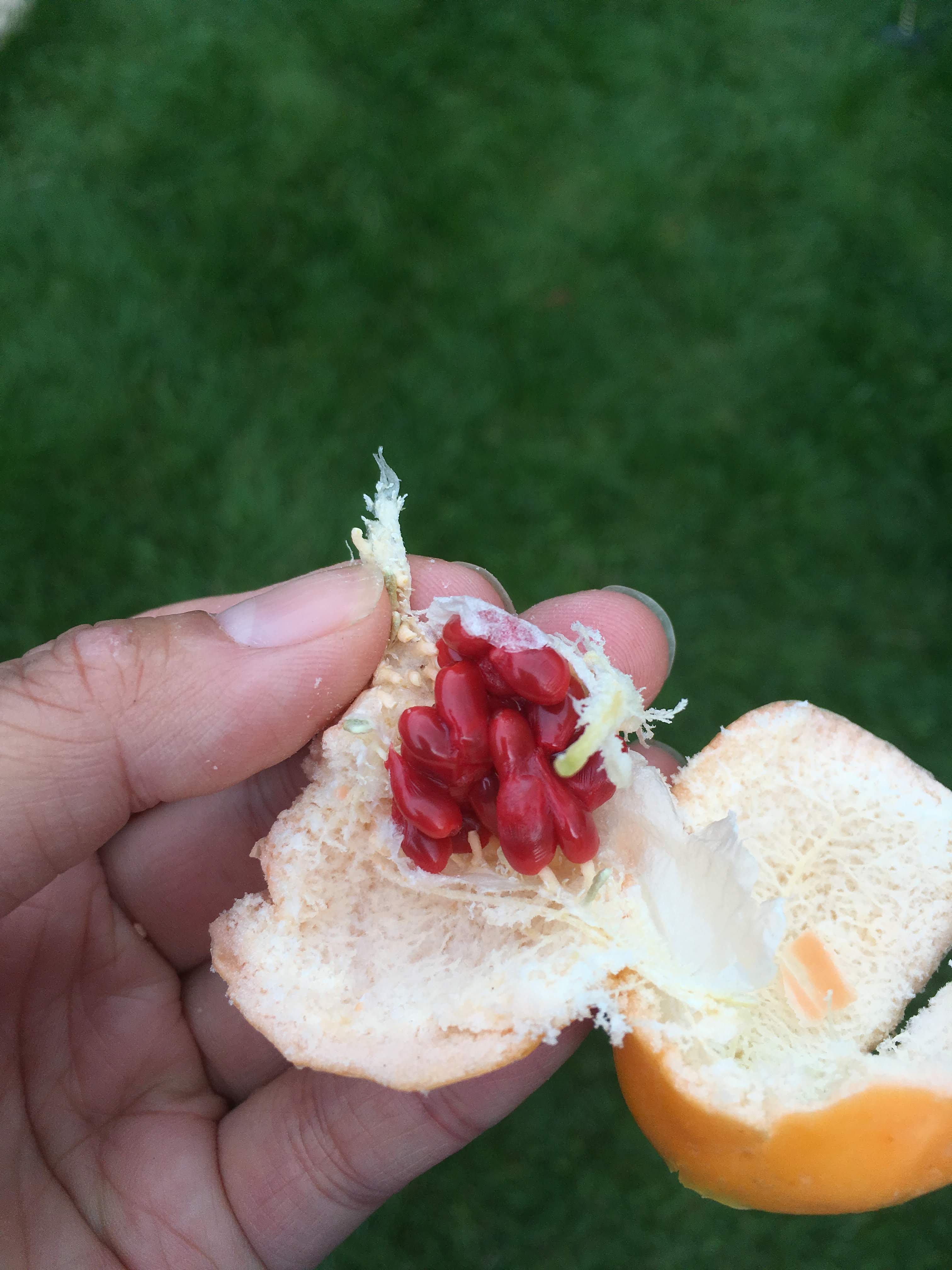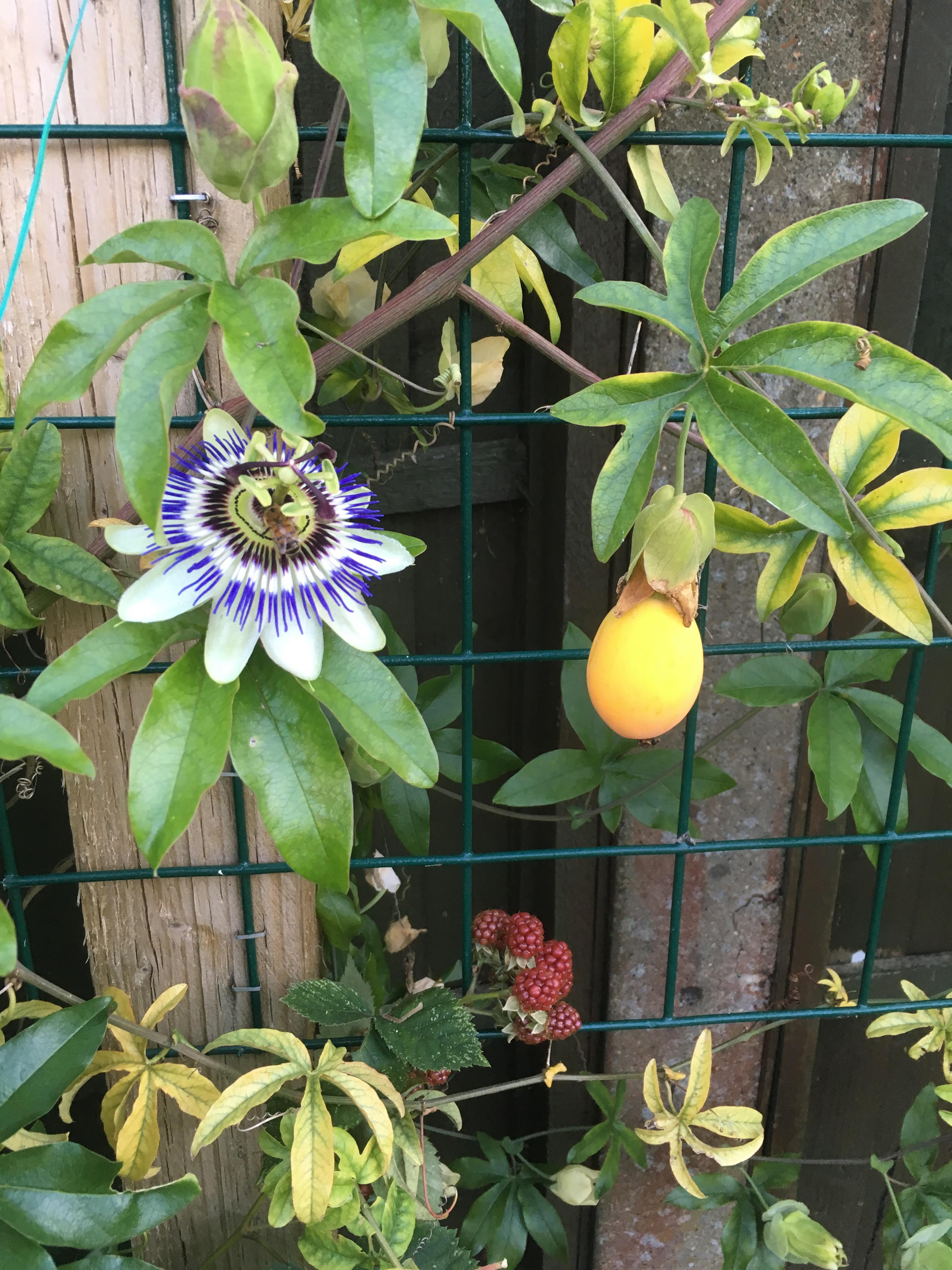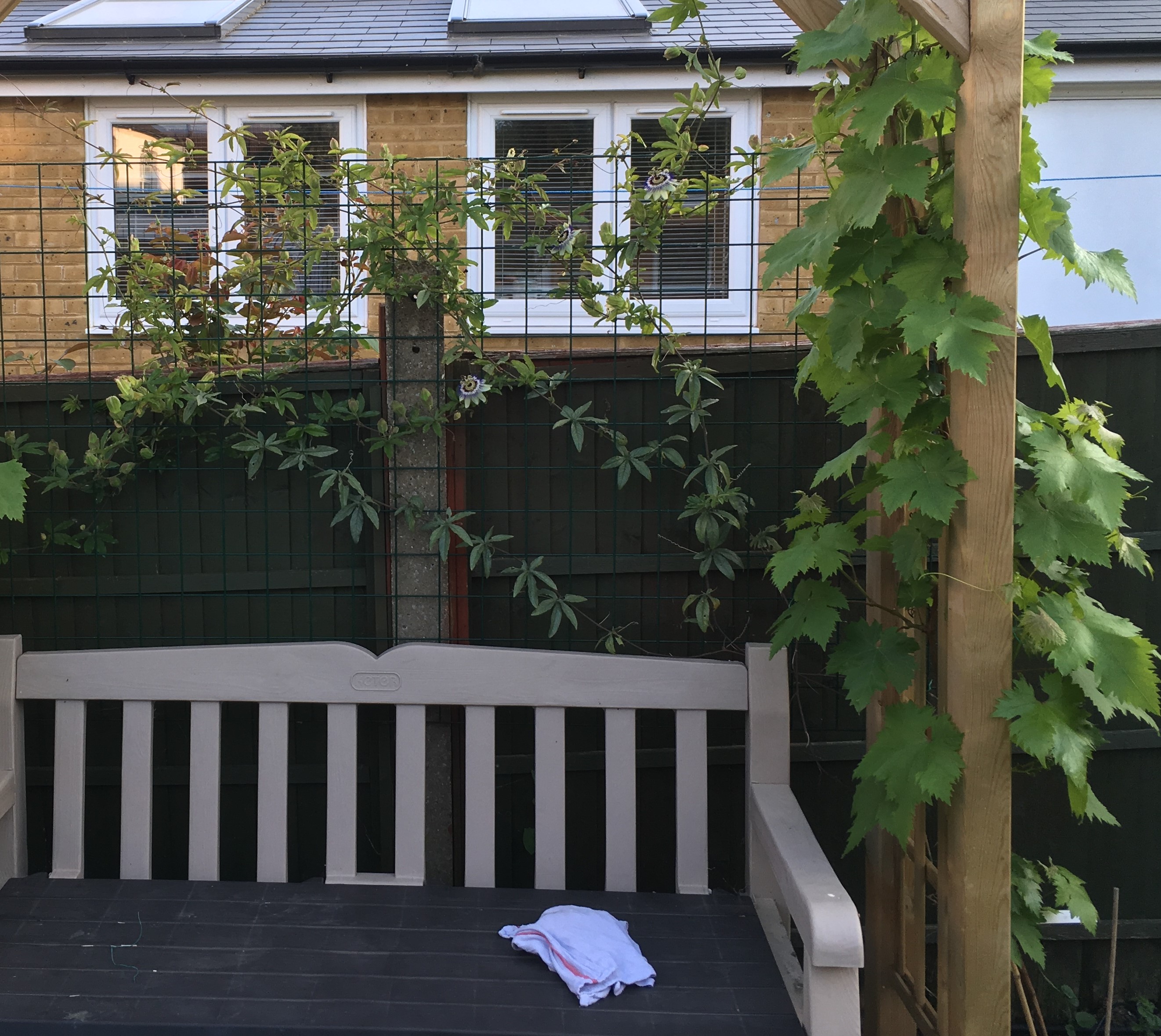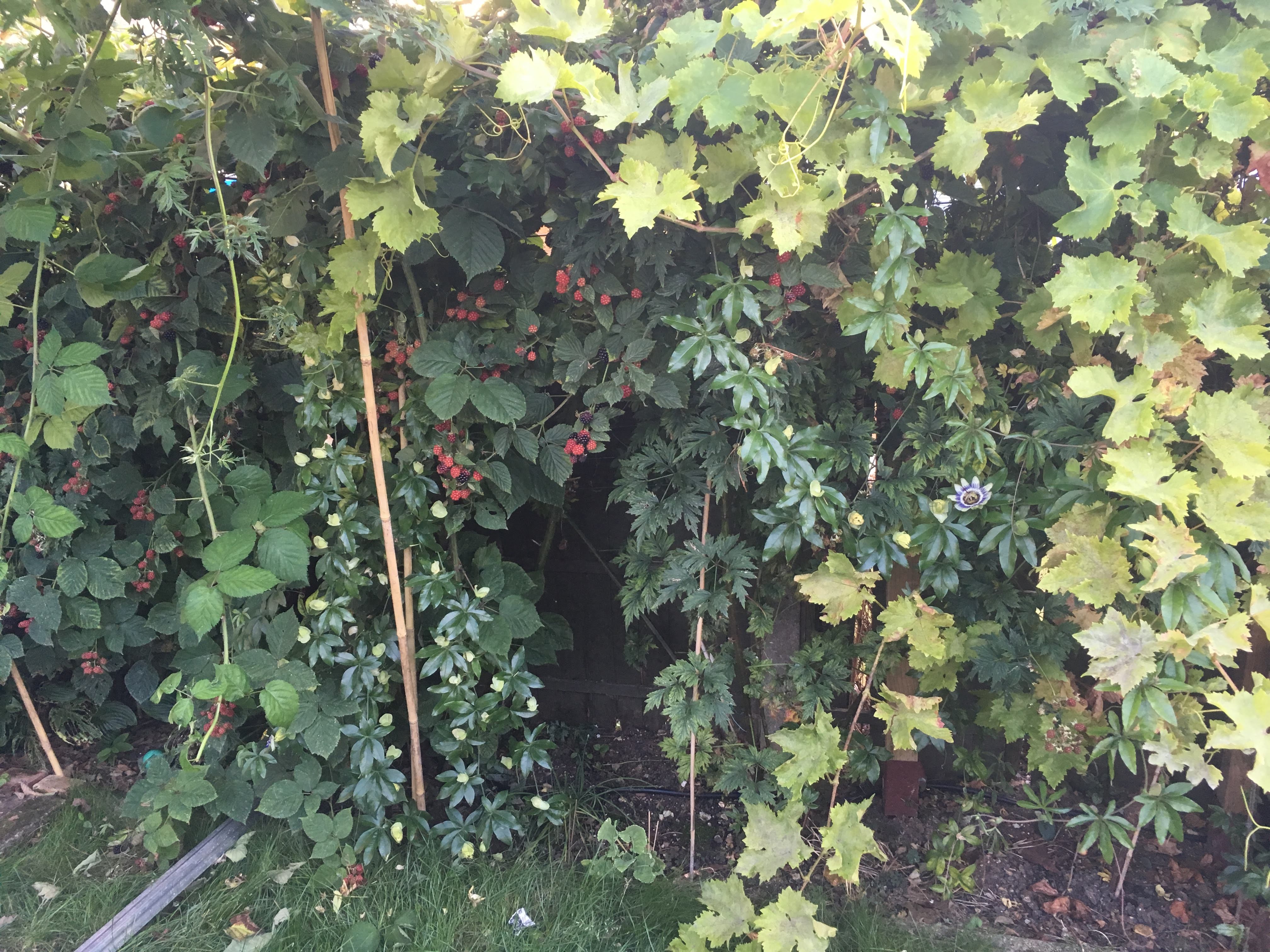
Short version:
I chose this passion flower because it was frost hardy perennial climber that grew in some shade, was evergreen and provided edible fruit. It has done brilliantly in my garden and has amazing flowers followed by orange, egg shaped fruit.
Passiflora / passion flowers are gorgeous as both a plant and a flower. The whole structure with its many dangling vines can transform a bare surface, whilst the individual flowers look incredibly exotic. There are many passion flowers of varying colours – but you may have noticed, I’m only interested if a plant is edible. I’m therefore, only talking about passiflora caerulea because it ticks all of my boxes.

My little one loves them too. Luckily, it produces a large amount of flowers so I don’t mind if she picks some of the ones growing more in shade as they’re unlikely to ripen into edible fruit.
Flowers
I really think they are stunning. It has a long flowering season. It can begin flowering (here in London) in late May and can continue till September. This will depend on the weather from year to year. The bees love them, and I often see them buzzing around the vines. This is of course also important for pollination so that the flowers will set fruit.
Fruit
Of course, it would be wonderful to grow passiflora edulis as these are the passion fruit that we recognise from the shops. Unfortunately, these wouldn’t survive the winter outdoors (I have neither the space nor the patience for greenhouse growing) and it certainly wouldn’t be warm enough in the UK alfresco for the fruits to fully develop. The caerulea is a decent substitution. The fruits are a gorgeous orange colour with a size and shape similar to a hen’s egg. These are edible – WHEN RIPE. When not ripe enough the fruit can cause tummy troubles. The fruit does need a good summer to ripen. A word of warning though – only the pulpy seeds are edible. The rest of the fruit should be discarded and the rest if the plant is also toxic. If this sounds worrying then to put your mind at ease – or maybe give food for thought – potato leaves are also toxic. Potatoes, along with tomatoes and aubergines are part of the nightshade family and none of the leaves of those plants should be eaten either. With any unusual edibles it’s a good idea to do your own research and read websites that you trust for information. I think that the Royal Horticultural Society is a good resource.

They’re soft enough to tear apart with fingers 
The seeds are inside a thin pouch 
Just these red seeds are edible. I’m afraid you won’t be getting much. 
You can see these ones changing colour 
It is still producing flowers, even as the fruit ripens. Chances are this flower’s fruit will not get a long enough sunny period to ripen.
Taste is also important. I won’t lie. They don’t taste much like the passion fruit we’re used to – but it tastes OK. Nothing amazing, but pleasant enough.
Vertical gardening

You can see the tendrils winding themselves round my wire frame. They will also happily entwine themselves round the stems of all nearby shrubbery.
It uses tendrils to climb up anything that will support it. In my garden it climbs the blackberries and the grape vine. It’s woven itself though the blackberry bushes and has resurfaced again about 4m away from the original plant.
The tendrils are great because this is not a plant that will damage brickwork, unlike ivy – which tunnels roots into mortar and is impossible to remove. I did mistakenly allow ivy to climb up a house once because I thought it was beautiful. When we came to move, I spent about 10 hours trying to remove the ivy. I yanked, scraped, scrubbed and brushed, but you could still see the debris of tiny roots entrenched in all available pores.
The climbing also means that it takes up a small footprint, which is a bonus for small gardens. You could have it scramble over a bike shed or to add colour and interest to a fence or wall.
Hardy perennial in British weather
The different varieties of passiflora vary in how hardy they are. Caerulea will survive outdoors fine and ours didn’t seem to be bothered by frost. In our garden in London it can be evergreen. It is deciduous to evergreen depending on how warm the local area is. Being evergreen means that it has made a great living screen by our fence. It has hopefully given our neighbours some protection from my child’s mooning (yes, that’s not a typo – but she is only 3 – and getting naked on private property seems to be her thing) and screaming (something else I think is also connected to being 3).
It also seems to do fine in shade. Its roots and the first 4 feet of the plant spends most of the time in shade. If you’re looking for edible fruit though, you’ll want it to grow in decent amounts of sun.
It returns year after year, despite freezing conditions. It does follow the adage: first year sleep, second year creep, third year leap – or it did for me anyway. First year it was a sorry looking thing with a few scraggly vines. The second year it provided a bit of privacy and one orange fruit.

This was in the first year. You can see the leaves poking out to the top right of the grape vine. The grape vines were to grow over the pergola and the passiflora was supposed to fill out the frame behind 
This was early in the second year, before it put on much growth.
This being the third year it covers a good 2 square metres or so. It has wonderfully flexible vines so I could weave it in and out of the frame however I liked. It also has about 20 or so fruit which are now all turning orange. With our current blackberry canes going mental and a grape vine in the middle, it is a little difficult to see where one plant ends and the other begins.

Behind the bamboo cane is a vine of the passiflora. It is about 4m from it’s roots… 
…which are right of the wooden post. You can see the little orange dots of fruit.
Doesn’t need looking after
In South Africa it counts as an invasive species that takes over indigenous plant life. I haven’t read anything that makes this plant a cause for concern in the UK. It doesn’t propagate particularly easily here, and I have never seen it anywhere in the wild. This does mean that it grows brilliantly, even with plenty of neglect. I’ve read that it in fact does best when allowed to get a little unruly and not kept too neat. They do grow to be quite large plants, though some patience is required in early years. When the plant is in its first couple of years and doesn’t look like much, don’t be tempted to fill in the space (like I did – doh!) with other perennials. If you want something vertical you could grow some peas, beans or maybe a cucamelon or another annual to fill in the gaps because this passiflora really will fill out.

It’s vigorous enough to cover a surface – but not so overly aggressive, like ivy, that you’ll continuously need to hack half of it down just to keep it in check. It’s easy enough to remove whole vines if you do need to keep it small. Pinching out the growing tips of the vines can help it to branch more.

It’s pretty cool as a pressed flower too!
If you’re looking to grow something that tastes amazing, I’m afraid this probably isn’t it. I’ve decided that there are still plenty of other reasons to grow these and I’ll continue to do so until I decide I need the real estate for something else. That something else is going to have to have all the bonuses of climbing, being hardy, being evergreen, be able to thrive on neglect, be bee friendly, be beautiful and then taste pretty wicked in order to trump passiflora caerulea.
So beautiful. My background is brick color..what plants would be tall and closest to brick
Merry Christmas from Russellville Kentucky, USA
LikeLiked by 1 person
Yes! They are gorgeous flowers! Happy New Year to Russellville!
I’m afraid I don’t know anything about growing zones in USA and I only really know about edibles. Do you mean something close to brick colour as in a colour scheme? Or something that would cling close to brick? Or even something that would benefit from growing close to brick. If you have a lot of brick about they can be very good at storing heat and helping plants like hardy kiwis grow, or for planting something like a grape vine, fig or peach tree near or fan train by. If you want something very red maybe a Virginia creeper for the gorgeous reds? Lots of clematis or roses will grow tall. Sadly clematis and the creeper are not edible. Roses are sort of. Not sure how tasty climbing roses are. Squashes and beans would climb pretty tall in a year. Any of this useful as a starting point?
LikeLike